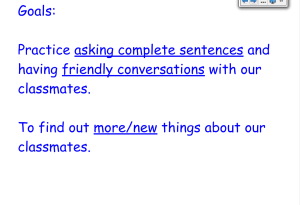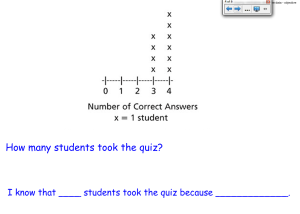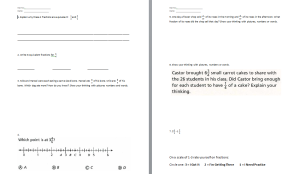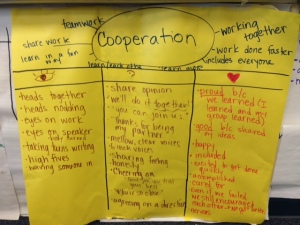Opener and Closer
Mrs. H 5th grade reading
The learning target of the activity was integrated into the activity with a brief introduction where the students were introduced with the learning target and the whole group read it aloud. Mrs. H mentioned that this specific learning target was not further discussed because it was a continuation from a previous lesson. During this observation, students did not articulate the learning target in their own words – they just repeated it. The opener did activate student prior knowledge by allowing students the opportunity to review their sticky notes on the evidence from the text. Students were able to communicate their learning through discussing the text and supporting it with the evidence they had collected on their sticky notes. I left before I could observe the closer to the lesson. After the class discussion, students were transitioning into small groups and/or independent work. These were both routines that have been established throughout the school year and students knew their expectations and began their work accordingly. What I liked was that the learning target was in direction relation with the Common Core standards. I feel that it is always important to integrate the state standard within any lesson. Students were able to demonstrate their understanding of the text in relation with the state standard through the student led discussion. This is another aspect I thought was particularly positive was that it was a student led discussion. Only when students were faced with a difficult question did the teacher interject. The teacher used turn and talk to prime their brains in order to answer the difficult question. Overall, the observation was a positive experience and in addition to observing the opener and close, I was able to see various teaching strategies implemented within the classroom.
Questioning
Ms. G 4th grade literacy
The teacher used question to informally check for understanding by reflecting on the previous day’s lesson. This lesson was a continuation for the literacy lesson which involved multiple days. Ms. G used both types of questioning – closed and open-ended questions in an equally distributed manner. Likewise, 3 boys and 5 girls were called during the whole group instruction. Of these students who were called upon, all the students were raising their hands. Not one did Ms. G call on someone who wasn’t raising their hands. She informally checked on students understanding throughout the lesson by asking students clarifying questions and checking for clarity by prompting students to show “thumbs up”. Ms. G also used questions like “can someone repeat what you are going to do when listening?” and “who haven’t I called on yet?” in order to ensure understanding and equality of student voice. In the middle on the activity, Ms. G had students discuss the objectives for the lesson activities. This was used as a check-in opportunity and for students to think back upon the goals for the lesson. Overall, I liked the questioning that was used. I felt that students were not pressured into answering and felt comfortable to share their thoughts and ideas. The equality of student voice between genders was good as well – even though the girls were the ones who were typically raising their hands. It was a good experience to really focus on just one aspect of a lesson and to really notice the little questioning strategies that were used throughout to ensure student engagement, understanding, and encouraging all students to share.
Classroom Management
Ms. H 5th grade reading
Based upon the pre-observation conference, what I observed was expected. This teacher mentioned the importance of having routines which is managed with firmness to indicate the urgency to cover materials. There were several classroom management techniques that were used throughout the lesson. One effective strategy that was used is the class has one person scouting throughout the lesson and during transitions. The teacher would say “your point or my point” which goes towards earning recess time. During each transition, Mr. H played music which was in relation with a time limit goal for transition. After the time limit, Mr. H would ask the point who earned a point. Another effective strategy was using the school-wide quiet sign. Mr. H would wait until the entire class was following expectations – students are who are or were not, she would say their name to get their attention/focus back. Likewise, Mr. H would wait to transition until the entire class was ready – which means seated and quiet. What I was able to learn from this experience was that playing music during transition time was really effective. It makes it a lighter atmosphere, instead of the teacher counting down. Also, students are able to listen to some music which I felt they enjoyed. I also appreciated the firmness which Mr. H ran her classroom but it was done in such a gentle and kind way in which students new their expectations and responded well towards. It was very quick paced as students were expected to go from task to task as independently as possible.
Instructional Strategies
Ms. W 3rd grade math
The math block for this class was separated into two sections. The first section involved a small group working with Ms. W (these students were lower achieving students) and the rest of the students were playing some sort of math game (like Blokus). In math, this class was being introduced to money. Ms. W working with the small group used play money in order to introduce proper money names and amounts. In addition to this, the emphasis was on recognizing the amounts for each money (nickel = 5 cents). I thought it was especially important to use play money as it provided a tactile/hand-on approach that really engaged the students. The ability to move and work with the play money really helped students understand the concept to be able to visually see that 5 pennies is the same as 1 nickel. After the first session was completed, the class was divided into two equal groups. One group had blue bin work (worksheets to work on with their partner) and one group was with Ms. W for group instruction. Ms. W used strategies of direct instruction, wait time, and pair-share opportunities to help deliver and meet the lesson objective. What was really effective for meeting the lessons objective (how to determine and estimate the values of money) was allowing students adequate think time in combination with students sharing their thinking on the smart board. I sensed that students really respected their classmate’s response and this help with student engagement because they all wanted to share their thinking.
Use of technology
Various teachers
I took a different approach for my use of technology observation, as all the observations I did included some use of technology in a similar manner. The main usage for technology in the classrooms at Stevenson is through the use of the classroom smart board. This is a very effective approach as you can create visual presentations and record student thinking directly on the smart board slides. Smart board also has the ability to save/print of specific slides if you wanted to display any around the class. This relates to the only negative thing I see with the usage of smart boards is that it does make it difficult to display student thinking that can be displayed on the walls – as a permanent reminder. Like I mentioned, you can print off slides but the biggest the copy machines can do is 11×17 which is not nearly large enough. To make larger copies, it would require utilizing the district printing services. Overall, utilizing smart board’s capabilities is an efficient means for reaching the learning target. As stated previously, recording or clarifying instruction/information on the smart board can be easily done because you can simply write on the specific slide. It also adds the component of an immediate response that is quick and effective during instruction. If you make a mistake, you can simply erase it and you can quickly write a response. I personally found using the smart board as an effective teaching approach. Having the slides really helped organize my instruction and kept a more steady flow through my lessons. It also provided an easy way to make spontaneous changes during a lesson because I could simply add a blank slide. This was helpful when misconceptions or misunderstandings arise and more clarification was needed. I consider myself a tech savvy person and I thought it was beneficial to the teachers and students alike for having a smart board in each classroom.
Extra-Curricular Observation
Soccer Practice
At Stevenson, they have several sports teams (basketball and soccer) that practices several times a week after school. They compete against the other schools in the district and practices are run by Stevenson staff or volunteers. What I observed was soccer practice for boys in the 4th and 5th grade which was coached by one of the teachers at Stevenson. Most of the interactions that I observed were student-to-student interaction as they were scrimmaging. The coach had interactions by leading and instructing the plays or drills during practice. I did not observe any type of behavior issue as all the students seemed happy just to be outside and playing a sport they loved. The coach and parent volunteers did not have to manage behaviors and students followed directions. Students were very engaged throughout the entire practice, eager to improve their soccer skills. I have a strong athletics background and I really enjoyed watching the soccer practice because of how well the students interacted. There was one point of the year when every day for almost 2 weeks there was some sort of issue with the students playing soccer during recess. Students would fight, argue, and complain. If became such a big issue that they stopped soccer for several days and when allowed to play again. They could do so only if one of the recesses supports staff was there to supervise. So it was very pleasant to observe students cooperatively playing and supporting their teammates during practice.









